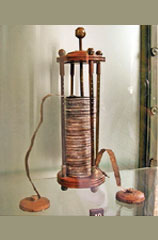Next
Between 1785 and 1805~
Uranium, Titanium, Vanadium, Chromium, Beryllium, Niobium, Tantalum, Cerium , Palladium, Rhodium, Osmium and Iridium had been discovered - mainly by elemental analysis.
Volta’s Cell by Alessandro Volta~
The Volta’s cell invented around 1805 played a crucial role in the discovery of new elements as it provided to chemists a steady source of electric current.

This is the original pile which Volta had designed.
It consisted of alternate discs of copper and zinc. Each pair was separated by a piece of cloth soaked in salt water.
Humphry Davy’s work in 1807~
Using Volta's cell, the English chemist Davy isolated the highly reactive elements namely sodium and potassium from their molten hydroxides. The discovery of these two metals is vital as they, being strong reducing agents, can displace other metals from their compounds.
Davy was able to isolate Calcium, Barium and Magnesium by the same technique a year later.
Berzelius used Potassium as a reducing agent and discovered Selenium, Silicon, Zirconium, Titanium and Thorium.
By 1830~
Along with the above elements, a few more elements- Boron, Lithium, Cadmium, Aluminium and Vanadium were discovered.
Next
Previous: Experiments 'Reveal' the Elements!